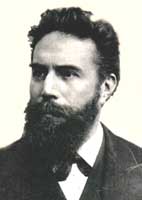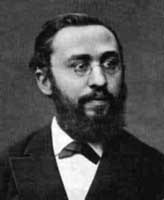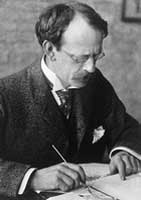Né le 18 juillet 1853 à Arnhem, Pays-Bas ; mort le 4 février 1928 à Haarlem, Pays-Bas. C'est un physicien qui reçut le prix Nobel de physique en 1902 et la Médaille Rumford en 1908. Il fut lauréat de la Médaille Franklin en 1917 pour ses travaux sur la nature de la lumière et la constitution de la matière. Il reçut également la médaille Copley en 1918.
La majorité de ses travaux portèrent sur l'électromagnétisme. Il a laissé son nom aux transformations de Lorentz qui sont à la base de la théorie de la relativité restreinte. Elles ont été présentées par Lorentz dans le but d'expliquer les résultats de l'expérience de Michelson-Morley par une contraction réelle des longueurs dans le sens du mouvement, ce qui n'est d'ailleurs pas compatible avec l'interprétation moderne de la théorie de la relativité restreinte qui affirme seulement que la mesure d'une distance ou d'une durée dépend du référentiel dans lequel se fait cette mesure et n'a donc pas de caractère absolu. La théorie de Lorentz implique également l'existence d'un référentiel absolu, le seul où les lois de l'électromagnétisme seraient applicables et d'un milieu, l'éther, qui servirait de support à la propagation des ondes électromagnétiques et qui serait fixe dans ce référentiel absolu.
Les travaux de Lorentz marquent les limites atteintes par la physique classique et constituent le lien entre la génération de Maxwell et celle d'Einstein et de Planck.
Lorentz lived from 1853 to 1928 and became known as the "Grand Old Man of Dutch Physics". He came up with the idea that the laws of nature must be invariant to a change of coordinate systems. The consequences of this were that time and space variables needed to enter into equations on an equal footing (same order of differentiation, etc.). Maxwell's Equations were readily made to be "Lorentz-invariant" and were then seen to be somehow very fundamental. These ideas laid the basis for the theory of special relativity a few years later. But new theories were always tested against this condition - if it wasn't Lorentz-invariant, something must be badly wrong. Schrödinger ran into this problem when he first tackled quantum mechanics.
Découverte de l'électron 1896
Travaillant sur les expériences de Faraday, Pieter Zeeman, doté de spectroscopes plus performant, nota un léger élargissement des raies du sodium dans un champ magnétique. Il communiqua sa découverte à H.A.Lorentz qui donna immédiatement une explication de ses observations.
Prix Nobel de Physique en 1902.
His principal work, however, was the study of the influence of magnetism on the nature of light radiation, started by him in the summer of 1896, which formed a logical continuation of his investigation into the Kerr effect. The discovery of the so-called Zeeman effect, for which he has been awarded the Nobel Prize, was communicated to the Royal Academy of Sciences in Amsterdam. But also demonstrated the negative nature of the oscillating particles, as well as the unexpectedly high ratio of their charge and mass (e/m). Thus, when in the following year the discovery of the existence of free electrons in the form of cathode rays was established by J. J. Thomson, the identity of electrons and the oscillating light particles could be established from the negative nature and the e/m ratio of the particles.
Découverte des isotopes
Travail sur le comportement des ions gazeux, en 1897, il confirme la nature corpusculaire des rayons cathodiques et mesure la vitesse des corpuscules et le rapport de leur charge à leur masse. Il approche la valeur de la charge de l'électron.
Prix Nobel de physique en 1906.
Thomson's early interest in atomic structure was reflected in his Treatise on the Motion of Vortex Rings which won him the Adams Prize in 1884. His Application of Dynamics to Physics and Chemistry appeared in 1886, and in 1892 he had his Notes on Recent Researches in Electricity and Magnetism published. This latter work covered results obtained subsequent to the appearance of James Clerk Maxwell's famous "Treatise" and it is often referred to as "the third volume of Maxwell". Thomson co-operated with Professor J. H. Poynting in a four-volume textbook of physics, Properties of Matter and in 1895 he produced Elements of the Mathematical Theory of Electricity and Magnetism, the 5th edition of which appeared in 1921.

Découverte des rayons X
Au soir du 8 novembre 1895, alors qu'il manipulait un tube de Hittorf et l'avait entièrement recouvert de carton noir, la pièce était sombre, et une plaque traitée au platino-cyanure se mit à fluorescer. Malgré toutes ses manipulations, la feuille émettait de la lumière. Il décida d'étudier le phénomène et dès le 22 décembre de la même année, il obtenait une première radiographie d'une main.
Premier prix Nobel de physique en 1901.
He theorized that when the cathode rays (electrons) struck the glass wall of the tube, some unknown radiation was formed that traveled across the room, struck the chemical, and caused the fluorescence.
Further investigation revealed that paper, wood, and aluminum, among other materials, are transparent to this new form of radiation. He found that it affected photographic plates, and, since it did not noticeably exhibit any properties of light, such as reflection or refraction, he mistakenly thought the rays were unrelated to light.
In view of its uncertain nature, he called the phenomenon X-radiation, though it also became known as Rontgen radiation.
He took the first X-ray photographs, of the interiors of metal objects and of the bones in his wife's hand.


